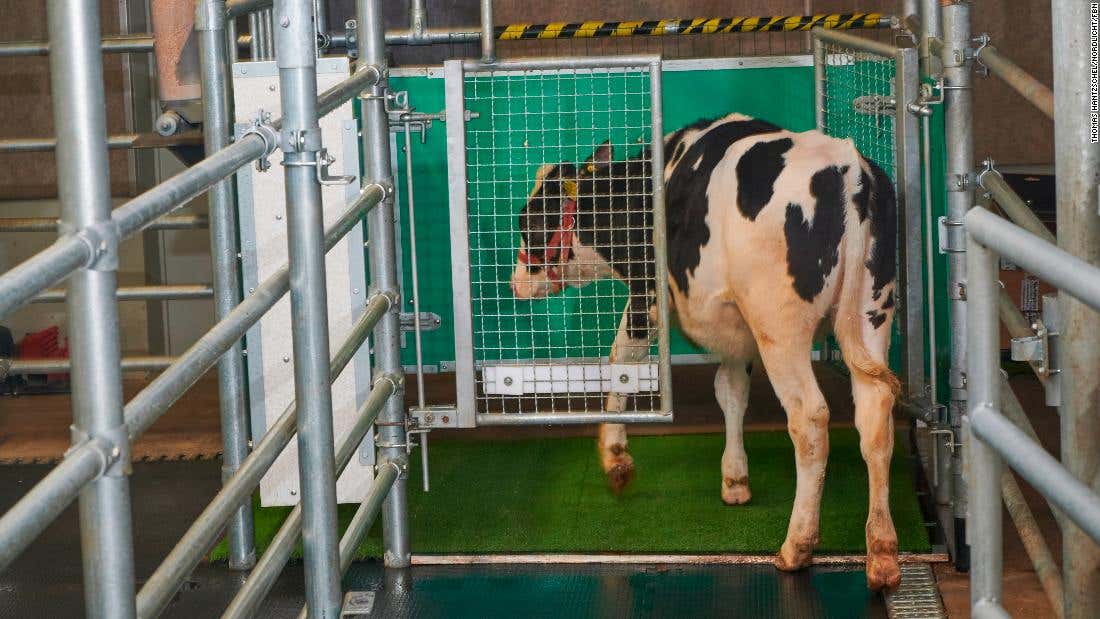Researchers are toilet-training cows to save the planet
On a farm where cows freely relieve themselves as they graze, the accumulation and spread of waste often contaminates soil and waterways.

[Sept 13, 2021: Cell Press]
On a farm where cows freely relieve themselves as they graze, the accumulation and spread of waste often contaminates local soil and waterways. This can be controlled by confining the cows in barns, but in these close quarters their urine and feces combine to create ammonia, an indirect greenhouse gas. In an article published on September 13 in the journal Current Biology, researchers show that cows can be potty-trained, enabling waste to be collected and treated, thereby cleaning up the barn, reducing air pollution, and creating more open, animal-friendly farms.
Successful toileting behavior of a calf (VIDEO)
“It’s usually assumed that cattle are not capable of controlling defecation or urination,” says co-author Jan Langbein (@niebgnal), an animal psychologist at the Research Institute for Farm Animal Biology (FBN) in Germany, but he and his team questioned this thinking. “Cattle, like many other animals or farm animals are quite clever and they can learn a lot. Why shouldn’t they be able to learn how to use a toilet?”
To potty-train the calves, a process they dubbed MooLoo training, the research team with scientists from FBN, FLI (Germany) and the University of Auckland (New Zealand) worked backward. They started off by rewarding the calves when they urinated in the latrine, and then they allowed the calves to approach the latrines from outside when they needed to urinate.
The ammonia produced in cow waste doesn’t directly contribute to climate change, but when it is leached into the soil, microbes convert it into nitrous oxide, the third-most important greenhouse gas after methane and carbon dioxide. Agriculture is the largest source of ammonia emissions, with livestock farming making up over half of that contribution.
“You have to try to include the animals in the process and train the animals to follow what they should learn,” says Langbein. “We guessed it should be possible to train the animals, but to what extent we didn’t know.”
To encourage latrine use, the researchers wanted the calves to associate urination outside the latrine with an unpleasant experience. “As a punishment we first used in-ear headphones and we played a very nasty sound whenever they urinated outside,” says Langbein. “We thought this would punish the animals—not too aversively—but they didn’t care. Ultimately, a splash of water worked well as a gentle deterrent.”
Over the course of a few weeks, the research team successfully trained 11 out of the 16 calves in the experiment. Remarkably, the calves showed a level of performance comparable to that of children and superior to that of very young children.
Langbein is optimistic that with more training that this success rate can be further improved. “After ten, fifteen, twenty years of researching with cattle, we know that animals have a personality, and they handle different things in a different way. They are not all the same.”
Now that the researchers know how to potty-train cows, they want to transfer their results into real cattle housing and to outdoor systems. Langbein hopes that “in a few years all cows will go to a toilet,” he says.
For more environment news stories check out our Green Impact section at The Brighter Side of News.
Like these kind of feel good stories? Get the Brighter Side of News' newsletter.
Tags: #New_Innovations, #Green_Good_News, #Climate_Change, #Ammonia, #Greenhouse_Gases, #Cows, #The_Brighter_Side_of_News
Joseph Shavit
Head Science News Writer | Communicating Innovation & Discovery
Based in Los Angeles, Joseph Shavit is an accomplished science journalist, head science news writer and co-founder at The Brighter Side of News, where he translates cutting-edge discoveries into compelling stories for a broad audience. With a strong background spanning science, business, product management, media leadership, and entrepreneurship, Joseph brings a unique perspective to science communication. His expertise allows him to uncover the intersection of technological advancements and market potential, shedding light on how groundbreaking research evolves into transformative products and industries.



